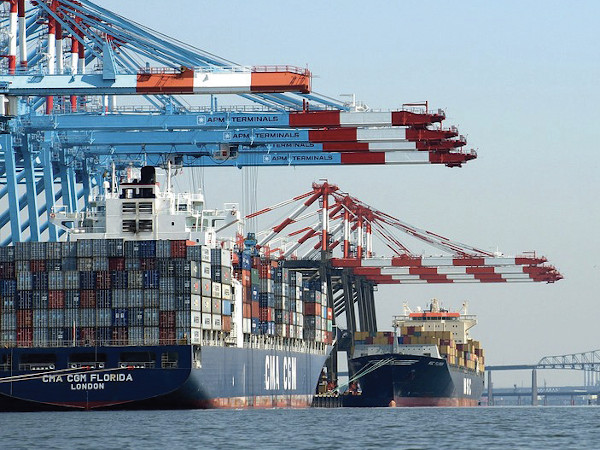Despite ripples and dislocations, the mainstream forces propelling global trade remain firm, says PANYNJ Port Director Sam Ruda.
The global economy is slowing, tariff wars may be suppressing international trade, and even consumer spending in the United States has become iffy. But none of that reflects the mood at the Port Authority of New York and New Jersey.

Not even President Donald Trump’s tariff machinations can cloud the prospects for the port, as far as Sam Ruda, the recently-appointed director of the port department at the Port Authority of New York and New Jersey, is concerned. “Some have suggested that cargo moved in early to beat the tariffs,” he said, in an exclusive interview with the AJOT. “I can’t say that hasn’t occurred. But if that were the entire explanation, we would then have seen a cargo falloff. So far we really haven’t.”
The Port Authority of New York and New Jersey is proceeding apace with its work planning for the future. The Port Authority recently released a new 30-year strategic plan which addresses, among other things, how it intends to make port operations more environmentally sustainable. (See Sustainability and resilience are drivers of NY/NJ port strategy )
Ruda attributes NY/NJ’s growth, even in the face of global trade head winds, to a number of factors. For one, larger container ships are now able to call on the port, thanks to the expansion of the Panama Canal, the raising of the Bayonne Bridge, and the deepening of port channels to 50 feet. Related to those developments, there has been “some shift in intermodal cargo from the West Coast to the East Coast,” Ruda noted. “We have grown our year-over-year intermodal volumes for the last four years.”
The Port of Authority invested over $600 million in the ExpressRail intermodal system since the 1990s. The opening of ExpressRail intermodal access at Global Container Terminal Bayonne earlier this year means that “basically every major terminal” at the port “has on-dock or near-dock intermodal capacity,” said Ruda.
Tariffs and Trade Lanes
East Coast ports like New York and New Jersey, unlike their West Coast cohorts, Ruda also noted, are less dependent upon trade with China, and therefore less subject to the current fluctuations in U.S.-China trade. Containers inbound from China make up over 60% of the container trade at West Coast ports, according to Ruda, while the same figure is in the low 30s at NY/NJ. “There are more trade lanes feeding into the East Coast,” he said. “We have Asia services that come through the Panama Canal and Suez Canal routings that come across the Mediterranean and the Atlantic, whereas the West Coast is almost exclusively dependent on its large transpacific trade.”
That’s why the slippage of a couple of percentage points in NY/NJ’s China trade hasn’t hurt the port, as it has gained volumes from India and Vietnam. “European traffic has also held up well,” said Ruda.

The increase in volumes from south and southeast Asia reflect supply chain shifts that were in the works even before the current era of tariff warfare. “Less capital and technology intensive companies will always chase lower cost areas,” said Ruda. “That feeds into places like Vietnam and Cambodia. Cargo from those areas often come through the Suez Canal rather than the Panama Canal and we tend to be first port of call on Suez routings.”
North-south trades may be the next growth area for the port as, in April, Seaboard Marine began a new service from NY/NJ’s Red Hook terminal in Brooklyn serving ports in El Salvador, Guatemala, Honduras, and Nicaragua. The services are expected to provide new business to NY/NJ to the tune of around 200,000 containers with cargoes including foods and beverages, sugar, and coffee.
Central and South America currently represent relatively modest volumes for the port, suggesting that there is room to grow. In 2018, imports from those markets constituted four percent of the containers handled at the port, while NY/NJ handled around 12% of the activity among the top ten imports from Latin America in 2018. Trade with the region has increased 14% at NY/NJ in the last five years, and volumes and imported wood and wood products from Latin America have nearly doubled in the same period.
Ten different container services from Latin America call on NY/NJ, with the emphasis on niche services and carriers. “I expect the perishable food segment to be a key part of the new north-south services calling at Brooklyn,” said Ruda, with bananas, plantains, fruits, and vegetables dominating the cargo mix, but with wines and spirits and some apparel cargoes also expected to be included.
“Our north-south trades to the east coast of South America, Central America, and the Caribbean are all small, but they are growing,” Ruda concluded.
Despite the brouhaha being played out in the media and in the public imagination over the tariff wars and their consequences, Ruda remains remarkably upbeat about the future of the port and for international trade writ large. “It seems like the parties are still talking, which is a good thing,” he said.
“But I look beyond the current administration, even if it is reelected,” he added. “The arc of forces is supporting more trade, not less. The networks of business relationships that companies have built over the years just don’t crumble quickly in the face of tariffs.”
Countries like Vietnam don’t have the capacity, the logistics infrastructure, or the human resources to duplicate what has been built in China. “There are also many high-tech manufacturing operations in China that simply can’t be easily replicated elsewhere,” said Ruda. “Besides the movement of finished products, there are also complex raw materials supply chains that support manufacturing and these can’t change on a dime.”
Coping mechanisms are also built into global trading systems, one of them being the weakening of the Chinese currency. “Cargo is still moving and I think it will continue to move,” Ruda concluded.





